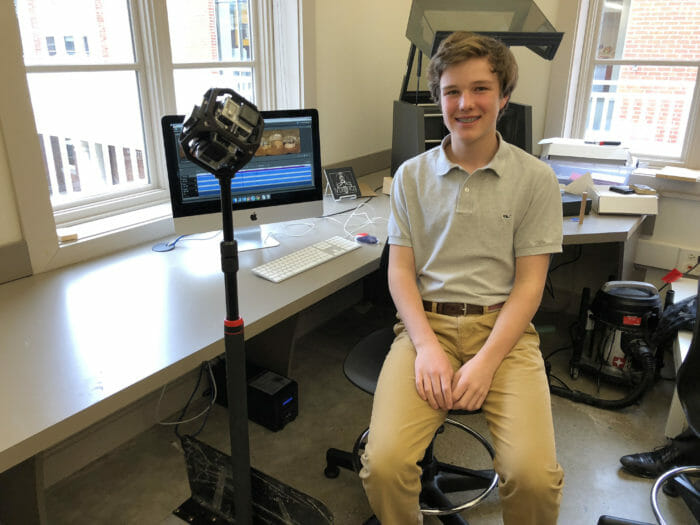Andrew Barren’22 created 360 degree films for Project Discover. Jacob Liu’20/Staff)
Every year around March, Columbus Academy 8th graders begin participating in Project Discover. As the name suggests, the project gives students the opportunity to explore new interests such as music, art, dancing, or in Andrew Barren’s case, 360 degree videos.
Barren initially became fascinated with 360 degree videos after going on Academy’s website and watching some videos that Mr. Cullinan, the Director of Technology, had shot of school plays and orchestra concerts. When Barren heard that he could choose 360 degree videos as his Project Discover topic, he reached out to Mr. Cullinan, who immediately agreed to help show him the ropes.
Under Cullinan’s guidance, Barren learned how to take six videos simultaneously using GoPro cameras mounted on all sides of a cube-shaped rig called the GoPro Omni. Since each camera is only responsible for capturing a portion of the entire spherical field around the rig, the resolution of the final product is more polished. Because the rig that Barren decided to use is cube-shaped, his videos are also made through a cubical projection. This minimizes the amount of distortion and redundant information once the video has been pieced together.
Kolor, one of GoPro’s subsidiaries, markets its editing software, known as Autopano, with GoPro’s Omni rig. With this software, Barren “stitched,” or pieced together all six perspectives into one fluid and interactive video. The software assists in the stitching process through advanced algorithms that search for similarities between videos.
After figuring out how to operate all of the equipment, the first official 360 degree video that Barren created was of the art gallery in Morris Hall, which currently features a pottery collection created by world-renowned ceramicist, Toshiko Takaezu. His second video was of the Lower School Clap-Out for the Upper School swimmers going to the state competition.
For his presentation that will take place on April 11, in the Dining Hall, Barren plans to utilize virtual reality goggles to provide his fellow peers with the chance to experience the sensation of standing inside his videos. As the videos are 360 degrees, one can turn around in place to see the entire view and interact with the virtual reality. To accommodate those who may not feel comfortable using the goggles, he will also have iPads and laptops to produce a similar but slightly less immersive effect.
Until then, Barren will continue to explore ways to improve the quality of his 360 degree videos.
When asked about his favorite aspect of learning how to shoot 360 degree videos for Project Discover, Barren said, “I think it’s really fun videoing it and putting it together and seeing in the end, how all the hard work turns out and getting to relive a moment that you otherwise can’t.”








